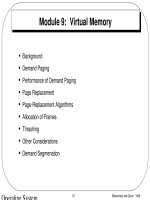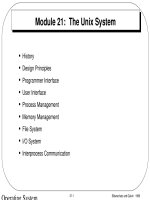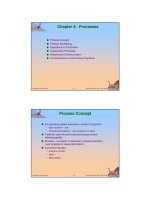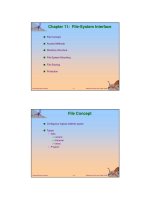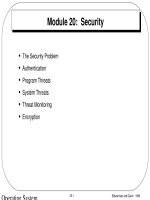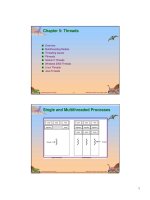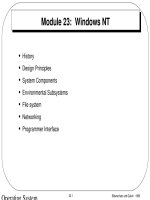Lecture Operating system concepts - Module 19
Bạn đang xem bản rút gọn của tài liệu. Xem và tải ngay bản đầy đủ của tài liệu tại đây (389.4 KB, 16 trang )
Module 19: Protection
•
•
•
•
•
•
•
Goals of Protection
Domain of Protection
Access Matrix
Implementation of Access Matrix
Revocation of Access Rights
Capability-Based Systems
Language-Based Protection
19.1
Silberschatz and Galvin 1999
Protection
•
Operating system consists of a collection of object|s, hardware or
software
•
Each object has a unique name and can be accessed through a
well-defined set of operations.
•
Protection problem - ensure that each object is accessed
correctly and only by those processes that are allowed to do so.
19.2
Silberschatz and Galvin 1999
Domain Structure
•
Access-right = <object-name, rights-set>
Rights-set is a subset of all valid operations that can be
performed on the object.
•
Domain = set of access-rights
19.3
Silberschatz and Galvin 1999
Domain Implementation
•
System consists of 2 domains:
– User
– Supervisor
•
UNIX
– Domain = user-id
– Domain switch accomplished via file system.
Each file has associated with it a domain bit (setuid bit).
When file is executed and setuid = on, then user-id is
set to owner of the file being executed. When execution
completes user-id is reset.
19.4
Silberschatz and Galvin 1999
Multics Rings
•
•
Let Di and Dj be any two domain rings.
If j < I
Di
Dj
19.5
Silberschatz and Galvin 1999
Access Matrix
Figure 1
19.6
Silberschatz and Galvin 1999
Use of Access Matrix
•
If a process in Domain Di tries to do “op” on object Oj, then “op”
must be in the access matrix.
•
Can be expanded to dynamic protection.
– Operations to add, delete access rights.
– Special access rights:
owner of Oi
copy op from Oi to Oj
control – Di can modify Djs access rights
transfer – switch from domain Di to Dj
19.7
Silberschatz and Galvin 1999
Use of Access Matrix (Cont.)
•
Access matrix design separates mechanism from policy.
– Mechanism
Operating system provides Access-matrix + rules.
If ensures that the matrix is only manipulated by
authorized agents and that rules are strictly enforced.
– Policy
User dictates policy.
Who can access what object and in what mode.
19.8
Silberschatz and Galvin 1999
Implementation of Access Matrix
•
Each column = Access-control list for one object
Defines who can perform what operation.
Domain 1 = Read, Write
Domain 2 = Read
Domain 3 = Read
•
Each Row = Capability List (like a key)
Fore each domain, what operations allowed on what objects.
Object 1 – Read
Object 4 – Read, Write, Execute
Object 5 – Read, Write, Delete, Copy
19.9
Silberschatz and Galvin 1999
Access Matrix of Figure 1 With Domains as Objects
Figure 2
19.10
Silberschatz and Galvin 1999
Access Matrix with Copy Rights
19.11
Silberschatz and Galvin 1999
Access Matrix With Owner Rights
19.12
Silberschatz and Galvin 1999
Modified Access Matrix of Figure 2
19.13
Silberschatz and Galvin 1999
Revocation of Access Rights
•
Access List – Delete access rights from access list.
– Simple
– Immediate
•
Capability List – Scheme required to locate capability in the
system before capability can be revoked.
– Reacquisition
– Back-pointers
– Indirection
– Keys
19.14
Silberschatz and Galvin 1999
Capability-Based Systems
•
Hydra
– Fixed set of access rights known to and interpreted by the
system.
– Interpretation of user-defined rights performed solely by
user's program; system provides access protection for use
of these rights.
•
Cambridge CAP System
– Data capability - provides standard read, write, execute of
individual storage segments associated with object.
– Software capability -interpretation left to the subsystem,
through its protected procedures.
19.15
Silberschatz and Galvin 1999
Language-Based Protection
•
Specification of protection in a programming language allows the
high-level description of policies for the allocation and use of
resources.
•
Language implementation can provide software for protection
enforcement when automatic hardware-supported checking is
unavailable.
•
Interpret protection specifications to generate calls on whatever
protection system is provided by the hardware and the operating
system.
19.16
Silberschatz and Galvin 1999

